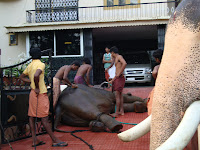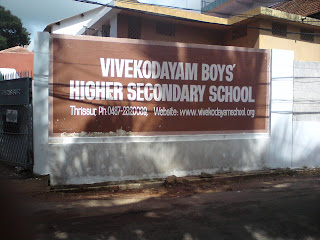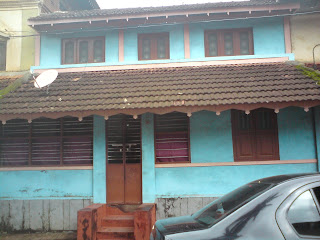
This is a dish which any“Madrasi’ (as the Mumbaiates call the South Indians ) would love to have in his daily eating menu whether for breakfast ,lunch or dinner.
This goes well with Vada, Idli or dosa and ofcourse with rice as well. In my house I can even have sambar with Chappathi also.
In Kerala this was mainly the dish for Brahmins and in fact in our school days Pattars ( Brahmins) were nicknamed as Sambar Kudikkum Pattars.
In the present days, this has become the national dish and it can be seen everywhere. The non Madrasis are seen to literally love it so much that they drink it with spoons.
Nobody seems to know the origin of this dish nor how the name sambar and its meaning,
During my browsing the net I came across a very nice justification of the origin of Samabar which I am reproducing below
Quote
The write up by Dr.Padmini Natarajan, which I quote Verbatim below: -
“South Indian food, people and culture are inexorably linked to a ubiquitous dish as in idli and sambhar, sambhar and rice and so on. Each state in the South prepares it with a typical variation, adapted to its taste and environment. The genesis of this dish has an interesting tale linked to it. The Marathas were ruling Tanjore. Sambhoji was a great cook (the male clan members to note) and very fond of his amti with a handful of the tart kokum thrown in. In a particular season the kokum that was imported from the Maratha homeland did not reach the bare larder of the king's kitchen. Sambhoji was cooking and the minions were shivering in their dhothis to tell
him that his favourite dish could not be made that day. A smart Vidushak, who had been elected sous chef for the day, decided to solve the problem. He whispered in the king's ears that the locals used very little tamarind pulp to gain a better sourness to the curry and that Sambhoji should experiment with this variation. Voila, the dish with the tuvar dal, vegetables, spices and the tamarind pulp was cooked and served by the king to his coterie. The court declared the dish an outstanding preparation (they had no choice with the king as Chef) and thus was born sambhoji's amti that in time became sambhar”
Thus the modern Sambar which we use is named after a king of Tanjore called Sambhaji. Due to distance from his native place and difficulty in getting Kokum, he used Tamarind and possibly added Toor dhal, which is mainly grown in Maharashtra and Gujarat. He might have added Pure Asafoetida which was used as a spice in Maharashtra. From then on lot of research must have gone in, in getting to the modern version of several types of Sambar.
Unquote
There are plenty of varieties of Sambar ,some of them I am giving below
Ulli Sambar ( small Onion)
Vendakkai Sambar ( Ladies Finger)
Muringakkai Sambar ( Drumstick)
Mulangi Sambar(radish)
Kerrai Sambar( spinach)
Mix. Veg Sambar
Capsicum Sambar and so on and so forth
This literally shows this dish can be made with any vegetables.
Every occasion whether it is Marriage ,Temple functions ,get to- gethers ,the one common dish will be the sambar. If you are in Karnataka or to be more specific Uduppi, sambar may have a slight sweet taste.
The Karnataka people have a unique concept. They make one dish with the coarsely ground paste of pepper, dhania and jeera seeds, red chilli, dal and coconut or copra and made into a vegetable stew. The curry is made quite watery and allowed to sit after cooking. The liquid that floats is laddled out and used as rasam and the thick bottom portion of the curry is eaten as sambhar. I understand this is typical of the Mandayam and Hebbar Iyengars. The sambhar that they cook otherwise has a dash of cinnamon and clove added that gives it the special flavour-it is used in their famous Bisi Bela Huli baath. Authentic Bisi bela has only tuvar dal, rice, puli, spices and onions. The addition of vegetables is a later development
The best sambar I have tasted is of course the one my mother makes, the recipe of which we are giving below.
INGREDIENTS
For Frying.
Channa dal 2kgs
Dhania seeds 2 kgs
Methi quarter tea spoon
Hing one teaspoon if powder or a mall piece
Whole red chillies 5 to 6
A few Baby onions, 4 to 5 curry leaves and two table spoon of grated coconut.
Other Ingredients.
Tamarind Lime size soaked and pulp removed One cup
Vegetables Baby onion one cup
Drum sticks 4 pieces
Capsicum One.
Cooked tur dal one cup
Salt, Haldi powder, mustard, oil dahnia leaves.
Method.
In a kadai add one tea spoon oil and roast the frying ingredients. Grind it with water to a fine paste. In the same kadai, fry the vegetables in a spoon of oil, pour the tamarind pulp on this ,add more water if necessary to cover the vegetables and let cook. Add haldi powder and salt to taste. When vegetables are cooked add the cooked dal and the ground masala, mix well and let boil well. Check for taste and consistency and add water if necessary. This sambar should not be very liquidy. Add one small piece of jaguarry to balance the taste. Temper in two table spoon oil, mustard seeds and garnish with dhania leaves.
Your sambar is ready.
I and my family always maintain that sambar like wine always tastes better as it ages.











































